Port McNeill, located in Canada, has ferry to Alert Bay. But Port McNeill is on Vancouver Island. So first you must ferry there.

- Port McNeill is a town on Vancouver Island known for its natural beauty and outdoor activities such as fishing, kayaking, and whale watching3.
- It is approximately 300 kilometers away from the Tsawwassen ferry terminal in Nanaimo1.
- On the drive from Nanaimo to Port McNeill, there are notable sights such as Cathedral Grove, a forest with ancient Douglas fir trees, and Little Qualicum Falls Provincial Park, which features a waterfall and hiking trails4.
- The history of Port McNeill dates back to the early 20th century when it was founded as a small logging and fishing community3.
- It is possible to board a tourist boat at Port McNeill to visit the Broughton Islands. Several companies offer whale watching tours and other excursions to the islands3.
- The Broughton Islands are known for their wildlife, including orcas, humpback whales, and dolphins. They also offer opportunities for hiking, kayaking, and camping3.

Overall, Port McNeill offers a range of outdoor activities, scenic drives, and access to the beautiful Broughton Islands, making it an attractive destination for nature enthusiasts and adventure seekers, one of which is Alert Bay.

Port McNeill became a settlement in 1936 and was named after Captain William Henry McNeill of the Hudson’s Bay Company2. Iron and copper mines around 1960 brought more people to live in the community. At incorporation as a village in 1966, the population was around 450. Completion of the Island Highway in 1979 greatly improved access to Port McNeill and the other communities along the northeast coast of Vancouver Island3. Today, logging remains the primary employer in Port McNeill and contributes approximately 8% of the total BC timber harvest. The main contractors are Western Forest Products and LeMare Lake Logging2. The town has seen significant changes in its economy in the past several years6.

Are there any nearby attractions to Humpback Inn in Port McNeill

Here is some information about the inn:
- The Humpback Inn is a hotel located in the heart of Port McNeill5.
- The hotel features free WiFi and free private parking124.
- It is situated approximately 44 km from the Port Hardy Ferry Terminal124.
- It is a short walk to the ferry to Alert Bay from Port McNeill.
- The hotel offers a range of amenities, including a kitchen or kitchenette, air conditioning, parking, a balcony or patio, a washing machine, TV, entertainment, a hairdryer, and non-smoking rooms3.
There are other nearby attractions to the Humpback Inn in Port McNeill, Canada. Here are some of the top-rated options according to search results:

- Remote Passages: A tour company that offers whale watching, grizzly bear watching, and other wildlife tours25.
- Jamie’s Whaling Station: A tour company that offers whale watching and bear watching tours2.
- Pacific Rim National Park Reserve: A national park that features beaches, hiking trails, and wildlife viewing opportunities2.
These attractions offer a variety of activities, including wildlife viewing, dining, and outdoor recreation. Visitors to the Humpback Inn can easily access these attractions during their stay in Port McNeill.

What are the features attractive to pleasure boaters of the marina at Port McNeal?

Pleasure boaters visiting the marina at Port McNeill can enjoy several features, including:

- Two moorage facilities to choose from2
- A natural harbor that provides a sheltered location for boats2
- The marina is open year-round and can accommodate boats of all sizes1
- The marina is a major re-supply point for boaters1
- The marina offers fuel dock services4
- The marina is conveniently located for provisioning and dinner reservations in Port McNeill45
- The marina is monitored on VHF 66A for slip assignments3
Overall, the marina at Port McNeill provides a convenient and well-equipped location for pleasure boaters to dock their boats and enjoy the surrounding area.
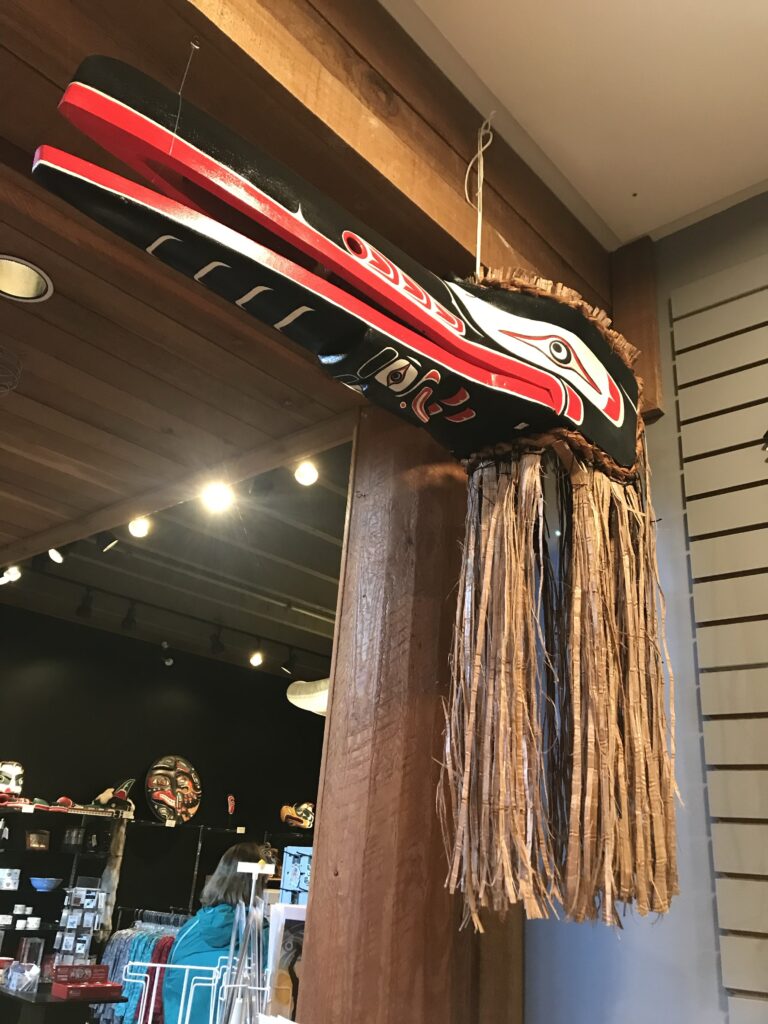
Are there any restaurants or cafes near Port McNeill Marina
There are several restaurants and cafes located near the Port McNeill Marina or a short boat ride away. Here are some of the top-rated options according to search results:
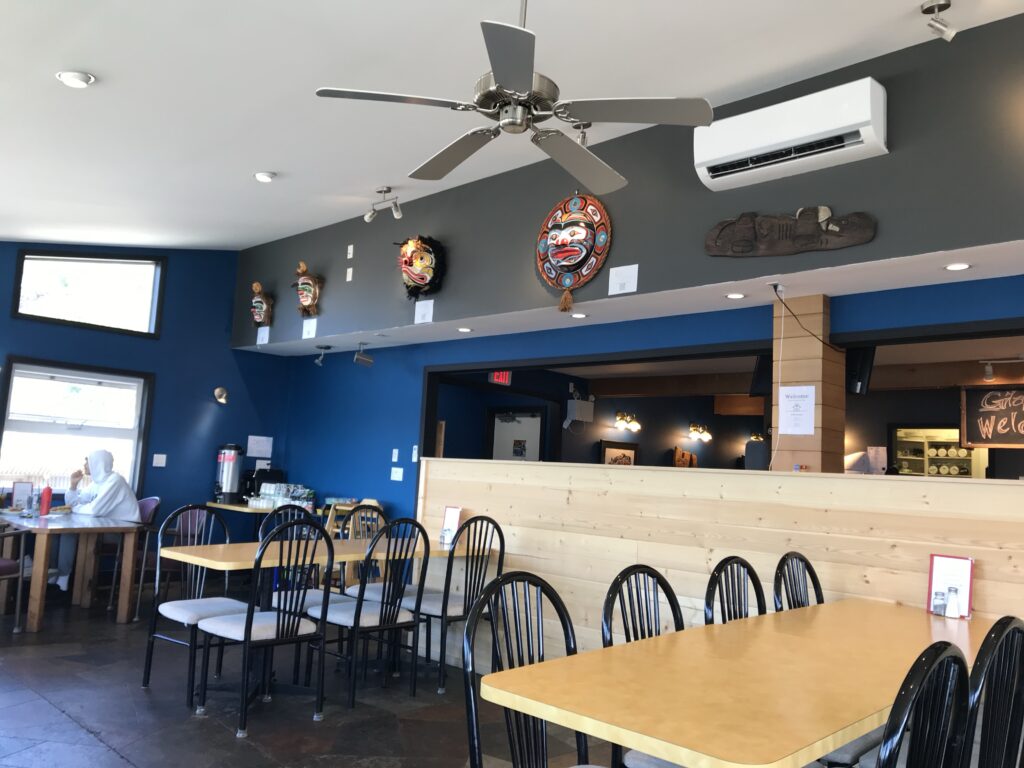
- Guss Pub13 at Port McNeill
- Seahorse at the Roxy Alder Bay1
- Tias Cafe123
- Gordies Restaurant & Lounge1 at Alert Bay
- Kwa’lilas Hotel1
- Archipelagos Bistro2
- The Sportsman’s Steak & Pizza House23
- Cluxewe Waterfront Bistro3
- Devil’s Bath Brewing Co. 3 at Port McNeil
- Mugz2.03
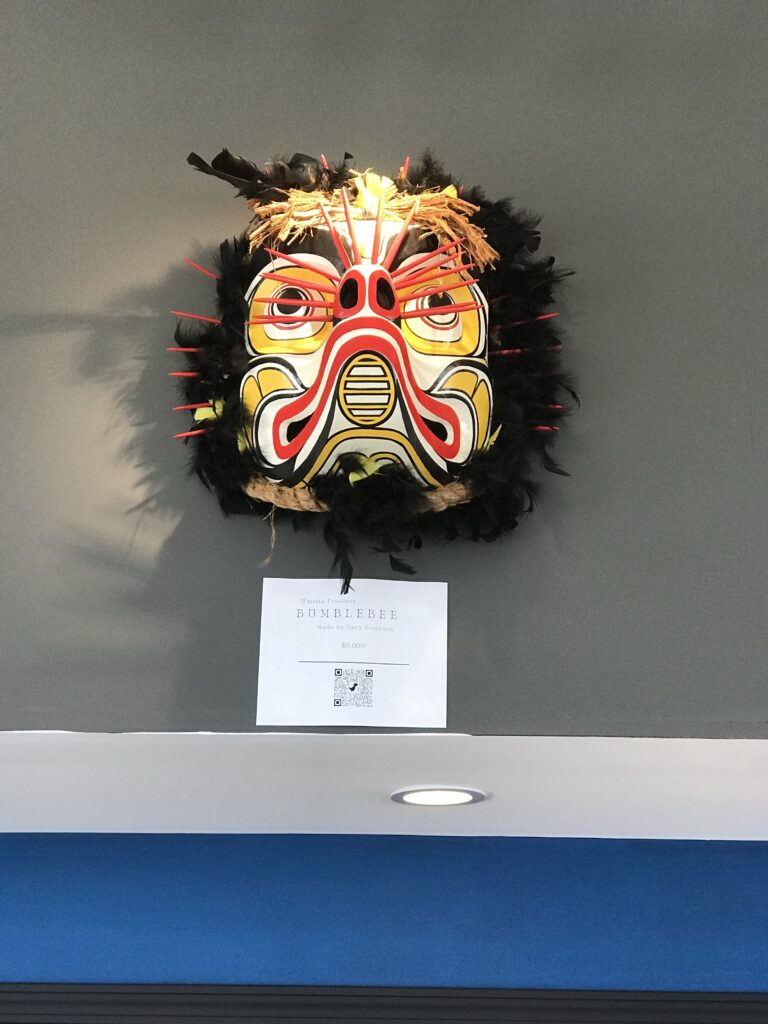

These restaurants offer a variety of cuisines, including pub fare, seafood, pizza, and more. Boating Visitors to the Port McNeill Marina can easily access these restaurants for a meal or snack during their stay.
What types of beer are available at Devil’s Bath Brewing Co.

Devil’s Bath Brewing Co offers a variety of locally crafted beers. According to the search results, some of the types of beer available at Devil’s Bath Brewing Co include:
- Morningstar Golden Ale1
- Sinners and Saints Hazy Pale Ale13
- Old Growth Red Ale23
- Bottomless Brown Ale1
- Belgian Wit2
- Sour Ale2
- Kölsch2
Visitors to Devil’s Bath Brewing Co can enjoy a range of beer styles, including pale ales, red ales, brown ales, and more.

Yes, Devil’s Bath Brewing Co. at Port McNeill serves food and beverages other than beer. They offer a food menu that includes tacos, salads, and artisan pizzas1. Additionally, they serve cider, wine, and various non-alcoholic beverages1.

Visitors can enjoy a combination of locally crafted beers and tasty culinary creations at the brewery and restaurant2. The kitchen offers a rotating menu2. It’s worth noting that while the focus is on their craft beers, they do provide options for those who prefer other beverages and food choices.

How do you get to Alert Bay from Port McNeil? What is at Alert Bay that is of interest? What Indians live at Alert Bay

To get to Alert Bay from Port McNeill, visitors can take a short ferry ride from Port McNeill to Cormorant Island, where Alert Bay is located235. The ferry ride takes approximately 40 minutes1. Once on Cormorant Island, visitors can explore the following attractions:

- U’mista Cultural Centre: A museum that showcases the history and culture of the Kwakwaka’wakw people46.
- Alert Bay Ecological Park: A park that features hiking trails and scenic views of the surrounding area46.
- Namgis Original Burial Grounds: A historic site that features traditional Kwakwaka’wakw totem poles and burial grounds46.

Alert Bay is also home to a small community of First Nations people, primarily the ‘Namgis First Nation23. Visitors can experience Indigenous culture and learn about the history and traditions of the Kwakwaka’wakw people during their visit to Alert Bay3.

Overall, Alert Bay offers a unique cultural experience and a chance to learn about the history and traditions of the First Nations people who call the area home.
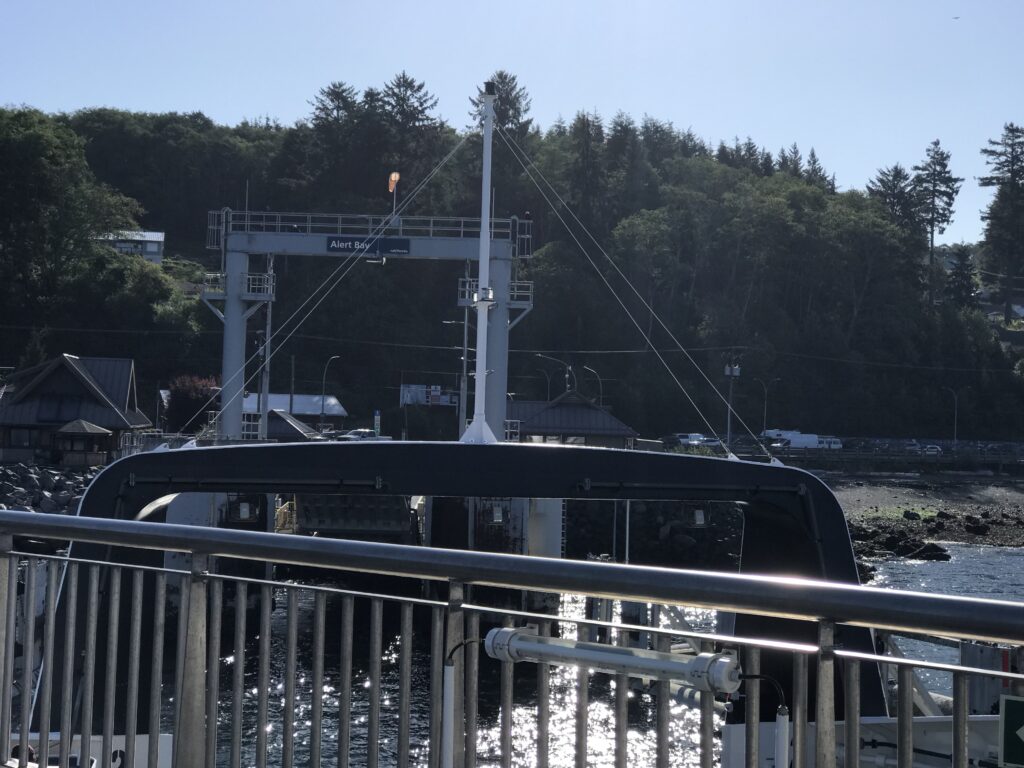
Alert Bay offers a range of cultural experiences that visitors can enjoy during their visit. Here are some of the top-rated cultural experiences available in Alert Bay according to search results:

- U’mista Cultural Centre: A museum that showcases the history and culture of the Kwakwaka’wakw people12345.
- Namgis Original Burial Grounds: A historic site that features traditional Kwakwaka’wakw totem poles and burial grounds14.
- Culture Shock Interactive Gallery: A gallery that offers a variety of traditional experiences, including carving, weaving, and drumming workshops4.
- Seasmoke Whale Watching: A tour company that offers whale watching tours and cultural experiences led by local First Nations guides15.
- Alert Bay Ecological Park: A park that features hiking trails and scenic views of the surrounding area12.

Visitors to Alert Bay can learn about the history and traditions of the Kwakwaka’wakw people, experience Indigenous culture, and enjoy outdoor activities during their visit.
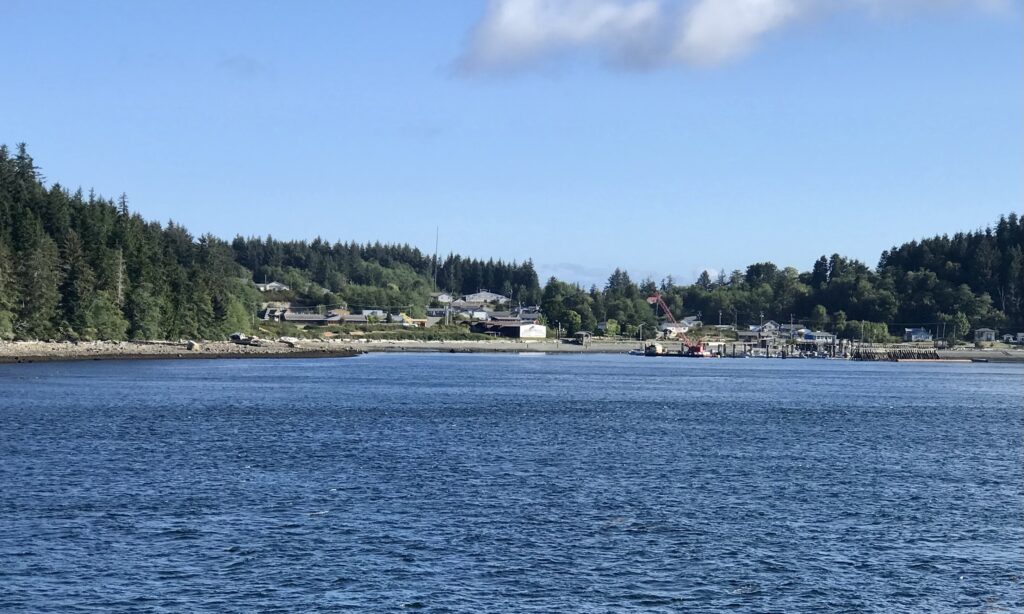
Are there any traditional events or festivals that take place in Alert Bay

Yes, there are traditional events and festivals that take place in Alert Bay. Here are some of the events and festivals that are mentioned in the search results:
- Alert Bay Traditional Dancers’ Festival: This annual festival features traditional Indigenous dance performances and is held in Alert Bay1.
- Alert Bay Seafest: This festival celebrates the maritime heritage of Alert Bay and includes boat races, a parade, and other activities2.
- Alert Bay 360: This event is a multi-sport race that takes place in Alert Bay and includes kayaking, mountain biking, and running2.
- Potlatch: A traditional Indigenous ceremony that takes place in Alert Bay and other First Nations communities5.

These events and festivals offer visitors a chance to experience traditional Indigenous culture and celebrate the heritage of Alert Bay.
ThE KWAKWARA’WAKW
(The Kwakwala Speaking Tribes)
Ever since the white people first came to our lands, we have been known as the Kwawkewlths by Indian Affairs or as the Kwakiutl by anthropologists. In fact, we are the Kwakwaka wakw, people who speak the same language, but who live in different places and have different names for our separate groups.

Some of the tribes of the Kwakwaka wakw have disappeared, among them the Awa’ettala of Knight Inlet, the Nakamgalisala of Hope Island, the Yuttinux of Cox and Lanz Islands. A few of the groups died out, while some amalgamated with other groups. Some of the villages have been abandoned for years.
Each group of people on earth has its own story of how it came to be. As Bill Reid says in his Prologue to Indian Art of the Northwest Coast:

“In the world today, there is a commonly held belief that, thousands of years ago, as the world counts time, Mongolian nomads crossed the land bridge to enter the western hemisphere, and became the people now known as the American Indians.
There is, it can be said, some scanty evidence to support the myth of the land bridge. But there is an enormous wealth of proof to confirm that the other truths are all valid.”
These are some of our truths.

Mamalilikala
‘Mimkwamlis (Village Island)
George M. Dawson, 1885, National Archives of Canada 37937
The Creator was going from one place to another changing and transforming the world into the shape that we see it today. He was at a place called Snake-receptacle when he saw a man sitting on a rock. That’s what the Yuttinux believe; the Mamalilikala say that the man was swimming along Archer Place. The Creator watched this man and realized that he was feeling around as if he were searching for something. He was blind.

So the Creator said, “Dive into the deep water and stay under as long as you can.”

And when the man did this, the Creator chanted “Mali, Mali, Mali”. When the man came to the surface, the Creator called out, asking him if he could see. “No,” said the man sadly. “Well, dive again and stay under just as long as you possibly can!” said the Creator. And when the man dove deeply, the Creator chanted again, «Mali, Mali, Mali». But, the man did not really stay under water for very long. And when he came to the surface, he told the Creator that he still couldn’t see. But, in fact, he could see.

The Creator’s cure had worked, but the Creator did not know this.
So, the Creator spoke to him and asked what he was doing. The man replied that he was starving and was searching about for something to eat.

“We will have to try it one more time,” said the Creator. So, the man dove a third time while the Creator chanted “Mali, Mali, Mali’. And the man dove so deep and stayed so long that he could see even the monsters in the darkest depths. And when he came to the surface, the Creator asked if he could see our world.

The man replied that he thought he could start to see a little light even though he was able to see very, very well indeed. So, Creator told him to dive one more time, and chanted Mali loudly while the man was submerged. And, as soon as the man came to the surface, Creator called out to him, “Your name will be Malilikala.”
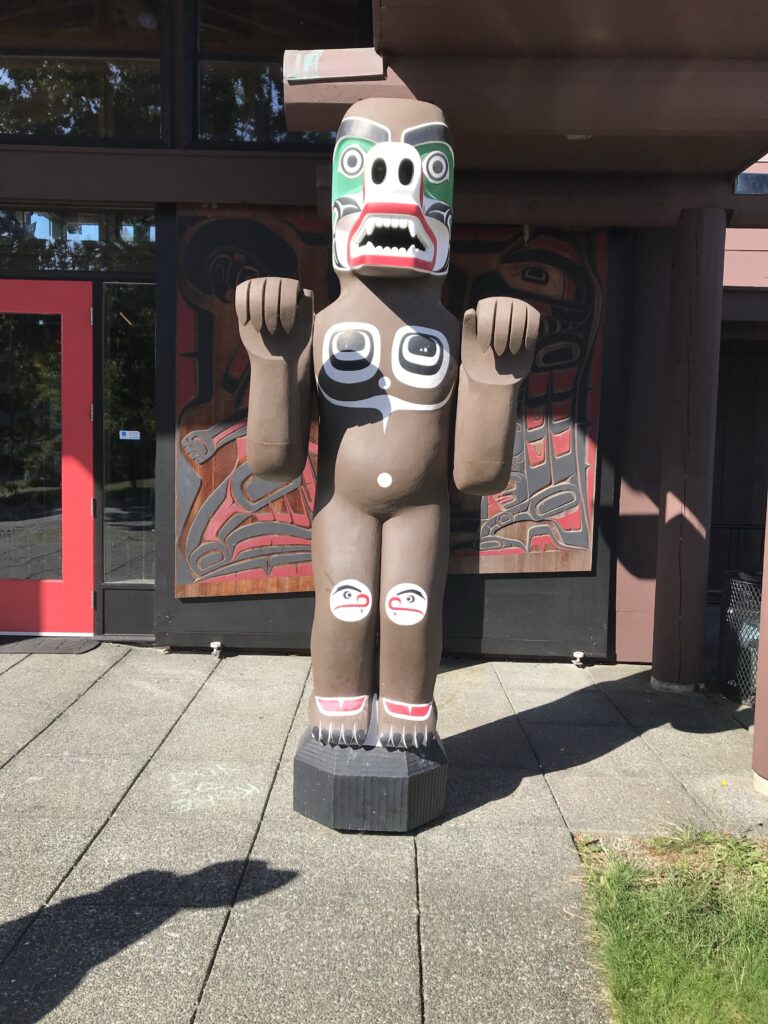
So, Malilikala built a house at the place called Two-headed. He was the first of the Mamalilikala.
‘Namgis
Xwalkw (Cheslakees)
W. Alexander (based on the sketch by J. Sykes, 1792,) Museum at Campbell River 9419
When the Transformer (or Creator), Kaniki’lakw, travelled around the world, he eventually returned to the place where Gwa’nalalis lived. In an earlier encounter, the Transformer had beaten Gwa nalalis, who was ready for his return. Kanikt’lakw asked,

“Would you like to become a cedar tree?” Gwa’nalalis replied, “No, cedar trees, when struck by lightening, split and fall. Then they rot away for as long the days dawn in the world.» Kaniki’lakw asked again, “Would you like to become a mountain?” “No, Gwa’nalalis answered, “For mountains have slides and crumble away for as long as the days dawn in the world.” The Transformer asked a third question. “Would you like to become a large boulder?” Again, Gwa’nalalis answered, “No. Do not let me become a boulder, for I may crack in half and crumble away for as long as the days dawn in the world.”

Finally, Kaniki’lakw asked, “Would you like to become a river?” “Yes, let me become a river that I may flow for as long as the days shall dawn in the world,” Gwa’nalalis replied.
Putting his hand on Gwa’nalalis forehead and pushing him down prone, Kaniki’lakw said, “There, friend, you will be a river and many kinds of salmon will come to you to provide food for your descendants for as long as the days shall dawn in the world. And so, the man Gwa’nalalis became the river, Gwa’ni.

Pal’ nakwala Wa’kas (Dan Cranmer) 1930
A’wa’ettala
Dzawadi (Knight Inlet)
R. Maynard, 1890, Royal British Columbia Museum PN 2291b
Among the ancestors of the A’wa’ettala is a woman who was a slave but escaped. She went upriver until she came to a house, and looking inside through a crack in the wall she saw two images of women. One image was made of a pile of mountain-goat hair, and the other image was a heap of spindles. Hearing someone approach, the woman hid. A man entered the house and nodded to the images of women saying, “Please speak to me and start to become real women.” Then he divided the mountain-goat meat which he had brought into two pieces and set one piece before each image. The next morning he left to fish.

The woman entered the house and, although she was hungry, she simply cooked the meat and laid it before the images of women. When the man returned that evening with fish he was pleased. He said, “Thank you, women, that you are now becoming women and are starting to work.” He placed a fish before each of the women and the next morning he went out again.
The woman again entered the house and cut and cooked the fish. Then she spun the wool, and finishing it she laid in on the ground where the image of the women had been. The man returned that evening and was again pleased because the women had begun to work. He spoke to them, saying, “Thank you for beginning to work.” And the next morning he went out again.

The woman then entered the house and burned the images all except for the feet, which she left laying beside the fire. When the man returned that evening he discovered the feet of those who had been his wives and he cried. He thought that the women had merely been jealous of each other. Then, the woman entered and sat by his side. She told him, I am the one who was really pictured in your images. ” And, then he married the woman and it was not long before she had many children. Then the men married their sisters and they became a large tribe. That is the end.
Adapted from Boas and Hunt, Kwakiutl Texts, 1905-6.
†sadzis’nukwame’ (New Vancouver)
C.F. Newcombe, 1900, Royal British Columbia Museum PN 242
Before the time of the great flood, the Da’nadaxw of Dzawadi knew that it would happen and began to prepare for it. Some of the people tied four canoes together and put their provisions in these. Dzawadalalis built a house of small poles, which he covered with clay. The others laughed at him, but he knew that he and his four children would survive the flood. When the rains came, the others tied their canoes to an elderberry tree, while Dzawadalalis began moving his belongings into his clay-covered house. One of the men who had ridiculed him said, “Please let me come with you,” but Dzawadalalis refused, saying “Go to the mountain, for that is what you said you would do. My children and I will be locked inside this house, for we are going underwater.”

Shutting the door, he began to sing,
“Take care of us. I am going where you have told me to go.”
Those people who had made fun of him floated around in the flood, which had reached the tops of the highest mountain in Dzawadi. For some time, Dzawadalalis and his children lived in their underwater house. Then he sent a small bird out. It returned to their house with a small piece of root in its mouth, and so Dzawadalalis knew that the waters were beginning to subside. He waited for a time, then sent another small bird out.
Again, it came back carrying evidence that the waters were still going down. The third time he sent a bird out, it brought back leaves from a tree. Finally, the fourth small bird was sent out and it brought back blades of grass in its mouth. Dzawadalalis knew then that it was safe to leave his underwater house. He instructed his children to open the door and thanked the Creator for saving them. They survived because they believed that they would be saved.
Wettaxa’as (Jack Peters) 1980
Dzawada’ enux
Gwa’ yi (Kingcome Inlet)
C. F. Newcombe, 1917, Royal British Columbia Museum PN 798
Before the Great Deluge happened, there were four wolves in the North. Three of the wolves were males and one was female. When the Deluge of the World came, the wolves climbed to the top of a large mountain called Having-Phosphorescence. The flood waters didn’t reach its summit and the four wolves were saved.

As soon as the waters subsided, the wolves came down from the mountain. The eldest of them took off his wolf-mask and said, “You also take off your wolf-masks, for we must finish being animals and from now on we will remain men. I shall have the name Listened-to, and you (the female) shall be called Healing-Woman, and you younger two brothers shall be Supernatural-one and Slow-in-house.
One day as the wolves-who-had-become-people sat, Listened-to grabbed his brother
Supernatural-One by the throat and bit him so that the younger man died. Taking a knife, wise Listened-to cut up the body into small pieces and made them into a ball. This ball he threw into the air, saying “Do not be sorry for what I have done to our brother. It is only because this is the only way in which we can increase in numbers. See!” And, as the ball of Supernatural-one’s flesh rose in the air, it became eagle down which was blown all over the world. Then, Listened-to said to the eagle down, “You will be the future men, and you will become many all round our world.” So, there were only two great men and a single woman who were the ancestors of all the tribes of the whole world.

In the course of time, Listened-to moved to Kingcome Inlet. Slow-in-House visited him there one day, and said, “Oh, brother Listened-to, how do the birds of your river here sing?” Listened-to answered him saying, “This is the song of the birds:
Dzawadzali, Dzawadzali.”
He referred to the robin. Then Slow-in-house said, “Thus, your people shall be called Dzawada’enux.” And when Listened-to asked his brother Slow-in-house what the birds sang near his home at Wakeman Sound, Slow-in-house referred to the lark and whistled, and chirped just like a lark. For that reason the people of Slow-in-house’s village came to be called Haxwa’mis

Adapted from Boas and Hunt, Kwakiutl Texts, 1905-6
Here is another version of this account:
When daylight first came to our world, two wolves became human beings. One was Kawadilikala, the first of the Dzawada’enux. The other became Kwalili, the first of the Hawa’mis. They lived for a long time at Gwa’yi, where their numbers increased. Both were Shamans. One day, they were playing a game, throwing a piece of quartz. Kawadilikala told his children, especially his daughter, not to look outside while the game was being played.

However, his daughter disobeyed and looked through a knothole in the wall of the house.
Kawadilikala was then unable to catch the quartz thrown to him and it landed on a mountain, now named for the quartz. Because he was so angry with his disobedient daughter Kawadilikala killed her, plucked her body to pieces, which became eagle down. He tossed the down into the air, where it floated away. So, Kawadilikala lost the game to his younger brother Kwalili.

Then, the two brothers prepared for the beginning of the great flood, by carving canoes.
Their treasure was the wolf dance and they had many wolf masks, which they put into their finished canoes, along with all their other masks. When the flood came, they anchored their canoes to the top of a high mountain called Kasidze. The canoe carrying the masks drifted away. After some time, the waters subsided and the brothers stayed where they were.

Kawadilikala howled like a wolf to the four corners of the world. From the land of the Gusgimukw came an answering wolf howl. Kawadilikala said to his younger brother, Kwalili,
“We are all right. The answer has come from others like us”, although they had never seen the people who answered.
Takwagila (Jim King) 1979
Kwikwasutinux
Gwa’ yasdam’s (Gilford Island)
C.F. Newcombe, 1900, Royal British Columbia Museum PN 235
The Thunderbird was living in the Upper World with his wife. The name of Thunderbird was Too-large. Now, Too-large was very downcast, and he spoke to his wife, saying, “Let us go to the Lower World, that I may see it.” Then his wife spoke to him, “Husband, do you know about your name, that you have the name Too-large, for you will be too big a chief in our Lower World?” Despite his wife’s advice, Thunderbird told her to get ready to go. Then he put on his

Thunderbird mask and his wife also put on her Thunderbird mask. They came flying through the door of the Upper World. They sat down on the large mountain, Split-in-two, near Gilford Island, and they saw a river at the bottom of it. Too-large said, “Let’s go down and look at that river.” So, they flew down to sit at the mouth of the river near where a man was working alone on his house.

These totem poles mark the gravesites of generations of Kwakwaka’wakw Chiefs and family leaders.
The man was struggling to raise a beam and said to the Thunderbirds, “I wish that you would become men so that you could come help me make this house.” Too-large lifted up the jaw of his Thunderbird mask and said, “Oh, brother, we are people!”
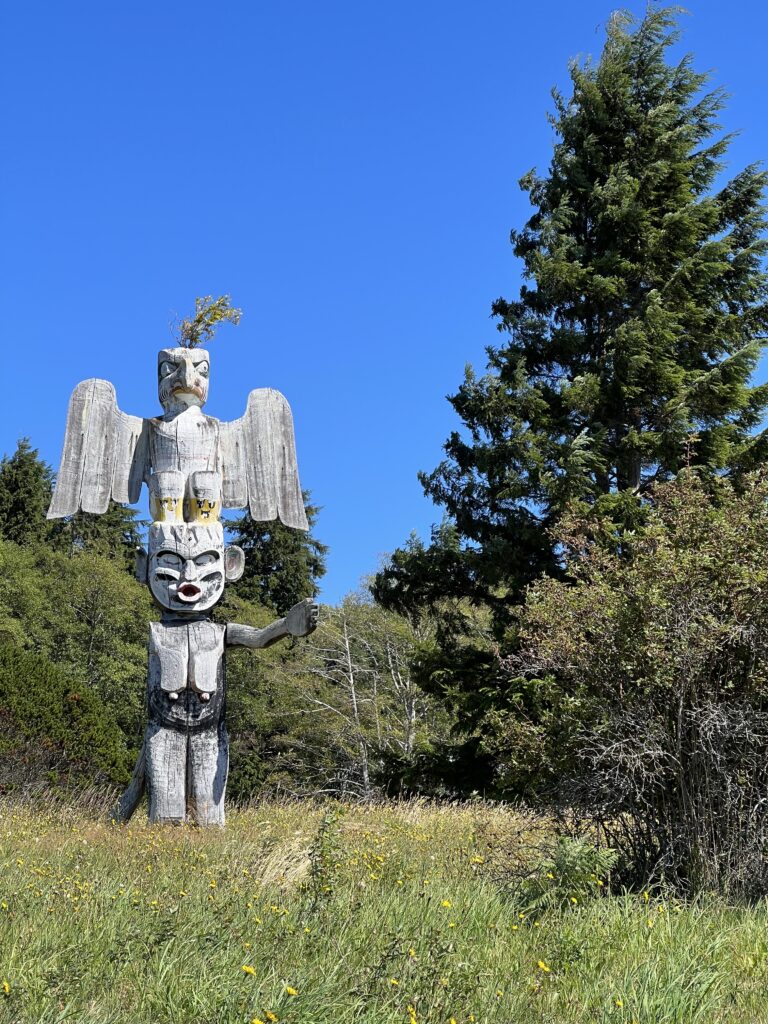
It is disrespectful to walk among the gravesites.
Then Too-large and his wife took off their Thunderbird masks and ceased being birds forever.
The man who had been Thunderbird said, “My name is Too-large in the Upper World, but now my name is Head-winter-dancer in this Lower World, and the name of my wife here is Winter-dance-woman.” So, Head-winter-dancer and Winter-dance-woman built a house on a hill and from them came a large tribe with much greatness.
Adapted from Boas and Hunt, Kwakiutl Texts, 1905-6
Gwawa’enux
Hegam’s (Hopetown)
Wilson Duff, 1955, Royal British Columbia Museum PN 2256
In the beginning there were a family of ancestors. The name of one man was First-Beaver, and he had a younger brother named Paddled-to. First-Beaver was very strong and twisted thick yew trees. He rubbed his body with hemlock branches. But Paddled-to was lazy and foolish. The father of First-Beaver felt badly because Paddled-to slept all the time. One day, the father kicked Paddled-to, and said, “Oh, you fool! Don’t think too much always of sleeping. Look at your elder brother. He is always rubbing his body with hemlock branches to make himself attractive to spirit powers.

Disgraced, Paddled-to decided to commit suicide. As soon as night came, he went to the woods and sat beside a lake. The waters of the lake rose and fell and when they were high a small devil-fish (octopus) swam around Paddled-to. The waters then rose so high they came to Paddled-to’s neck, and the devil-fish grabbed him and grew large by sucking his blood. Paddled-to was carried off under the water by the devil-fish, who took him to the under-water house of the one who is called Wealthy because he controls all of the creatures of the water. Wealthy treated Paddled-to well and taught him the secrets of supernatural power. He introduced Paddled-to to all of the creatures of the water by taking him on an underwater trip as far as Bella Coola. Wealthy also made Paddled-to a gift of all the dancing paraphernalia used by his descendants todav.

Then, Wealthy sent Paddled-to home, but first he said, “You shall no longer be Paddled-to; from now on you will be called Born-to-be-head-of-the-World.” Upon finding his family, the one who had been Paddled-to changed into a whale and an eagle came and sat on the fin of the whale. Born-to-be-head-of-the-world’s father said, “Look, this eagle seated on a whale shall be our crest. Finally, Born-to-be-head-of-the-world changed himself into a sea otter and swam into a long bay. His family followed him, and leaving the water he became a man again. Pointing to the shore, which is Hegam’s (Drury Inlet), he said, “I wish this to be a village site.” The ancestors of the Gwawa’enux then went to work.
Adapted from Boas and Hunt, Kwakiutl Texts, 1905-6.
“Nakwada’×w
Ba’as (Blunden Harbour)
C. F. Newcombe, 1901 Royal British Columbia Museum PN 248
The first of the Ten-clan-tribe, the ‘Nakwada’xw, lived at the narrow entrance by Ba’as. Their chief was Chief-of-the-Ancients, whose younger brothers were Shameless-deer and all of the myth people. Old Chief-of-the-Ancients was always greatly troubled because there was no river near their village. So, one day he called all of his younger brothers and said, “I feel badly because there is no river near where we live. It is a chief’s responsibility to assure the well-being of the community, so I am going to look for a wife who is a twin, for twins are salmon who have assumed the form of men, and on account of my wife the various kinds of salmon would also come. There fore, I wish to make a river here that the various kinds of salmon would come.” Thus he spoke to his younger brothers.

So, first all of them went to one end of Narrow-entrance and dug out a place for the future river.
Then, Chief-of-the-Ancients walked to a river some distance away and drank deeply from it, keeping the water in his mouth rather than swallowing. Walking back to the site of their river, he let the water in his mouth one the plain above the proposed river. There it made a lake and water commenced to flow out of the lake and down the new river. So, what Chief-of-the-Ancients had carried in his mouth became a huge river.

Then, Chief-of-the-Ancients went in search of a twin. His aunt, Star-woman, told him to go to the village of the Myth-people and seek among their graves. So he went and sought among the graves for a twin. He had almost given up when he found one, and taking the bones, he sprinkled them with the water of life… and a very pretty twin woman came to life. “Why do you come and make me alive, Chief-of-the-Ancients?” she asked. Her name was Salmon-maker, and she became the wife of the old chief. And salmon soon came to meet her up the river that the chief had provided for his people forever.
Adapted from Boas and Hunt, Kwakiutl Texts, 1905-6.
Gusgimukw
Xwatis (Quatsino)
B. W. Leeson, 1895, Vancouver Public Library VPL 14044
The Gusgimukw first lived at a place called Guse’. The Transformer (or Creator), Hitatusala, visited there during his travels around the world. There were only two people in the village, an old woman and a child. When asked why they were alone, the old woman replied, “All of our people have been eaten up by a monster in the river. Whenever someone has gone to get water, the monster has eaten them.” Hitatusala then asked the child to get him some water, for he was thirsty. The child was afraid to go, but Hitatusala told her that she had nothing to fear, as he put his sisyutt belt around her. Still afraid, the child took a water bucket and began walking towards the river.

Buried in the sand was the huge tongue of the monster. Without knowing it, the child walked right onto the monster’s tongue and was swallowed. Hitatusala began to sing, which made the monster appear and vomit an immense pile of bones as well as the child it had just swallowed. “Now, we will get to work so that your tribe will increase in size again” Hitatusala said to the child. They began putting the bones together in the right way to form bodies.
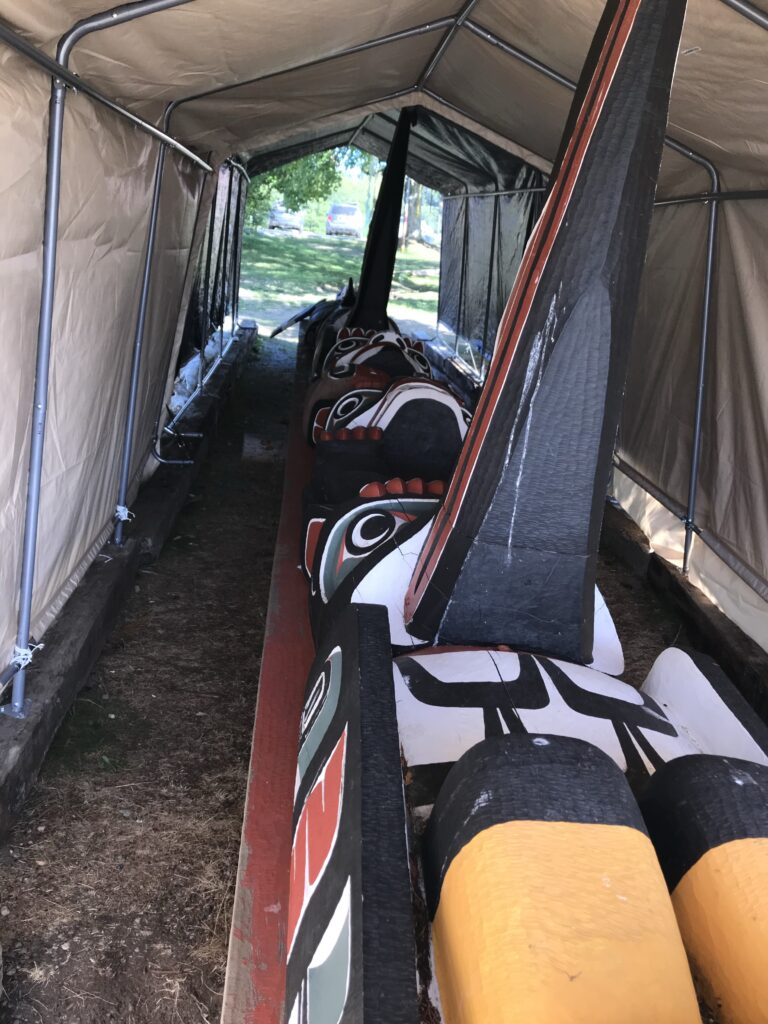
This is not from neglect. Some families purposefully let the poles fade, fall down and decompose as part of the natural cycle of life and death. Some families believe that the ancestor’s spirit has left once the totem falls down. Other families prefer to install new poles or repaint the old ones as they fade.
Raising the memorial pole for
When they were finished, Hitatusala sprinkled his life-giving water on the assembled bones and the people whose bones had lain on the beach came to life and stood up. They said to each other, “I must been sleeping a long time.” Hitatusala told them, “You weren’t sleeping!
You were dead and I brought you back to life. Now I will rid the river of this monster.” He shouted at the monster to show itself again. It did so, and, taking hold of it, he flung it away, saying, “You will not come again; you will be gone!”
‘Walas (James Wallas) 1980
Weka’ yi
T’sakwa’lutan (Cape Mudge)
Trio Crocker Collection, date unknown, Royal British Columbia Museum PN 11708
Listen, and I will tell you of the first of the Ligwitdaxw, who lived in a village at the place named Tilted Ground. There was a great Shaman living there who always cured the sick ones and was paid with slaves, canoes, and princesses of the chiefs. This shaman had a rival who was very jealous of his power, Young-shaman. Young-shaman went every day to bathe and purify himself.

All T’sit’ satwalagame’ descend from the first man.
One day as he was seated by the river he heard a noise in the Salalberry brush nearby. He threw a piece of bark in the direction of the noise and it ceased, so he went on home.
The next day, Young-shaman and his brother went in their canoe to collect seagull eggs. They saw a large kelp on the water and going down to great depths, so Young-shaman told his brother,
“I think that I will go down this kelp to see what the underpart of the sea is really like. Don’t be frightened for me, but come looking for me along the beach every day.” Then, Young-shaman crawled down the kelp.

When he had crawled to a great depth, Young-shaman saw a house below. Descending to the roof, he heard someone inside remark that something was rustling the roof-bards. Soon a man came out to investigate and invited Young-shaman to come in. Inside the house there were a great number of shamans trying to heal a heavy chief, lying on a reed mat on the floor. The shamans were having no luck. Young-shaman waited until all of the other shamans had given up before going over to examine the chief, who was moaning in pain. Turning the chief on his side, he noticed the piece of bark which he had thrown at the noise in the salalberry brush, sticking into the side of the chief, but not easily visible because of the rolls of fat. So, Young-shaman pretended to suck out the illness of the chief. Four times he sucked mightily, and only then did he pull out the piece of bark so quickly that no one could see him do it. The ill man became well at once and praised Young-shaman loudly, saying, “I am Wealthy, chief of the creatures of the sea, and I give you a great supernatural spirit power as a gift. With it you can overpower any other shamans.” And with that, Young-shaman left to go back home.
Welcome to the j’mista
His brother found him dead on the beach the next morning, but when Young-shaman felt his brother’s touch he came back to life. People in the village were amazed at Young-shaman’s new power…except for the older shaman, who thought it was a trick. Pretending to be ill, the older shaman asked Young-shaman to heal him. Young-shaman realized at once that the older man was not ill, and therefore he tore the heart, liver, intestines, and lungs of the treacherous older shaman to bits and drew them out of the man’s anus, killing him. Young-shaman continued to be a great healer, taking the name Kate’nats, and becoming the ancestor of many people.
Adapted from Boas and Hunt, Kwakiutl Texts, 1905-6.
The Meaning of U’mista In earlier days, people were sometimes taken captive by raiding parties. When they returned to their homes, either through payment of ransom or by a raid, they were said to have u’ mista.

The return of our treasures from distant museums is a form of u’mista
Many people believe that a rich and powerful person is someone who has a lot. The people who speak Kwakwala, the Kwakwaka’wakw, believe that a rich and powerful person is someone who gives the most away. Since a time beyond memory, the Kwakwaka wakw have been hosting potlatches and potlatching continues to play a central and unifying role in community life today.
The potlatch was banned in Canada between 1885 and 1951. The potlatch masks and other regalia that you see in the Potlatch Gallery were all surrendered under duress to the police after an illegal potlatch in 1921. After the ban was lifted, the Kwakwaka’wakw people fought for decades for the return of their sacred regalia that had ended up in museum and private collections around the world. Most of the regalia has come home and it is shown here at the U’mista Cultural Centre and at the Nuyumbalees Museum near Campbell River.

‘na’mima. ‘Na’mima means “those of one kind,” and is used in a similar fashion to the word ‘clan’ in other indigenous groups.
The word “potlatch” means “to give and comes from a trade jargon, Chinook, formerly used along the Pacific coast of Canada. Guests witnessing the event are given gifts. The more gifts given, the higher the status achieved by the potlatch host.
The potlatch ceremony marks important occasions in the lives of the Kwakwaka’ wakw: the naming of children, marriage, transferring rights and privileges and mourning the dead. It is a time for pride – a time for showing the masks and dances owned by the Chief or host giving the


